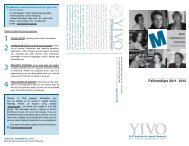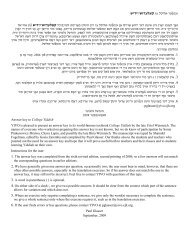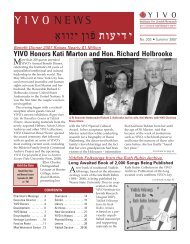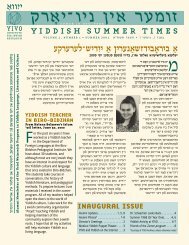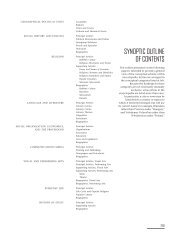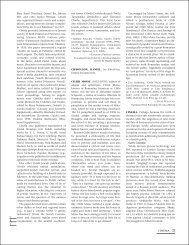<strong>Jewish</strong> Spaces 163of life was very different in these various places. In a famous essay the German<strong>Jewish</strong> sociologist Georg Simmel (1858–1918) has described thepsychological conditions which the metropolis creates. With each crossing of the street,with the tempo and multiplicity of economic, occupational and social life, the city sets up adeep contrast with small town and rural life . . . The metropolis exacts from man as a discriminatingcreature a different degree of consciousness from that required by rural life,where the rhythm of life and sensory mental imagery flows more slowly, more habituallyand more evenly.Simmel highlighted some of the specific features of life in the big city: its intellectualquality, its dependence on production <strong>for</strong> a national and internationalmarket, its extreme division of labour, and the requirement of punctuality which itimposed on those who earned their living here. These characteristics made socialrelationships qualitatively different from those in small towns. The city atomizesits inhabitants and isolates them from each other, which makes them both moreindifferent to each other and also more prone to conflict. At the same time, itaf<strong>for</strong>ds its denizens an unprecedented freedom from the ‘trivialities and prejudiceswhich bind the inhabitants of a small town’. 1This chapter examines the specific conditions in which Jews lived, first in smalland market towns and then in the large towns whose emergence was such a characteristicfeature of nineteenth-century Europe.THE SHTETL IN THE NINETEENTH CENTURYWhen it comes to the nineteenth century, we have nothing that compares with thedetailed studies of Rosman and Hundert on <strong>Jewish</strong> small towns in the seventeenthand eighteenth centuries. The legal situation of the Jews in these towns changedsignificantly. The abolition of serfdom and feudal conditions, first in PrussianPoland and then in Galicia, the Congress Kingdom, and the Pale of Settlement,did away with the rights of the noble owner of the small town. With the exceptionof the tsarist empire, where the laws restricting <strong>Jewish</strong> rights of residence weretightened after 1881, Jews could now live in any part of any town. Throughout thisperiod Jews remained a key element of the rural economy and retained their role asintermediaries between the estate and the village. However, social stratificationbecame more extreme in the <strong>Jewish</strong> small town, as some profited from the commercializationof agriculture and the new links with the outside world while otherswere impoverished by the disappearance of their traditional occupations.We are dependent, above all, on fiction <strong>for</strong> our understanding of what washappening in this period. The maskil Israel Aksenfeld provides a very vividdescription of <strong>Jewish</strong> small towns in the closing years of the Napoleonic period inhis novella Dos shterntikhl (The Headband):1Simmel, ‘The Metropolis and Mental Life’.
164 <strong>Jewish</strong> SpacesAnyone familiar with our Russian Poland knows what Jews mean by a small shtetl, a littletown.A small shtetl has a few cabins, and a fair every other Sunday. The Jews deal in liquor,grain, burlap, or tar. Usually, there’s a man striving to be a Hasidic rebbe.A shtot, on the other hand, contains several hundred wooden homes (that’s what they calla house: a home) and a row of brick shops. There are: a very rich man (a parvenu), severalwell-to-do storekeepers, a few dealers in fields, hareskins, wax, honey, some big moneylenders,who use cash belonging either to the rich man, going halves on the profits, or tothe tenant farmers and tenant innkeepers in the surrounding area. Such a town has a Polishlandowner (the porets) with his manor. He owns the town and some ten villages, this entiredistrict being known as a shlisl [Polish: klucz, ‘key’]. Some prominent Jew, who is held inesteem at the manor, leases the entire town or even the entire district. Such a town also hasa <strong>Jewish</strong> VIP, who is a big shot with the district police chief. Such a town has an intriguer,who is always litigating with the town and the <strong>Jewish</strong> communal administration, even onthe level of the provincial government. In such a town, the landowner tries to get a Hasidicrebbe to take up residence, because if Jews come to him from all over, you can sell themvodka, ale, and mead. All these goods belong to the landowner, and so up goes his income.Such a town has a winehouse keeper, a watchmaker, and a doctor, a past cantor and apresent cantor, a broker, a madman, and an abandoned wife (an agunah), community beadles,and a caterer. Such a town has a tailors’ association, a burial association, a Talmudassociation, and a free-loan association. Such a town has various kinds of synagogues: a shul(mainly <strong>for</strong> the Sabbath and holidays), a bes-medresh (the house of study, <strong>for</strong> everyday use),and sometimes even a kloyzl (a smaller house of worship) or a shtibl (a small hasidic synagogue).God <strong>for</strong>bid that anyone should accidentally blurt out the wrong word and call thetown a shtetl. He’d instantly be branded as the local smartass or madman.A town is called a big town if there are a couple of thousand householders and a few brickbuildings aside from the wooden homes. This is a horse of a different colour. Here, everyoneboasts that he greeted someone from the next street because he mistook him <strong>for</strong> anout-of-towner. After all: In such a big town as this, how can you tell if a stranger is a local?There are tons of people whom you don’t know from Adam. 2This description is helpful in distinguishing the different types of town, but itsaccount of the town’s <strong>Jewish</strong> inhabitants is essentially social satire and shouldnot be taken <strong>for</strong> a representation of reality. For these inhabitants, the shtetl wasa kehilah kedoshah, a holy or covenantal community. As such, it maintained, asAksenfeld describes, the essential institutions of shul (synagogue), beit midrash(study house), shtibls (hasidic houses of prayer), ḥeders (elementary schools),mikveh (ritual bath), and besoylem (beit olam, cemetery). These provided <strong>for</strong> thecommunity’s religious needs just as the various voluntary societies and professionalguilds (ḥevrot) organized the social interaction among the Jews themselves.This ideal often failed to live up to reality, and the maskilim, like Aksenfeld, thussaw the shtetl as the root of <strong>Jewish</strong> backwardness. They were quick to point out2Dos Shterntikhl, in Neugroschel (ed.), The Shtetl, 49–50. The description later says that the eventstake place in 1812–13.







